|
|
|
History A monastery, probably housing Vallambrosan monks, was here before it became a house of Silvestrine Benedictine monks in 1290. The Silvestrines themselves were later moved to San Giorgio dello Spirito Santo, having been accused of living 'without poverty and without chastity'. They made way for Observant Dominican friars from San Domenico in Fiesole, who were stricter Dominicans than the Conventuals at Santa Maria Novella. They took possession of the complex on March 15th 1436, with nine friars coming from the convent at Fiesole, including Fra Angelico. They found that the dissolute Silvestrines had left the buildings in perilous ruin, burning parts of the buildings and stripping them of their furnishings. The Medici family had been involved in the church's lavish celebrations of the Feast of the Epiphany, held here since 1417, which featured a procession celebrating the journey of the Magi by a confraternity of which they were members, with a performance in the piazza in front of San Marco. The Pope, then installed in Santa Maria Novella, is said to have encouraged Cosimo to fund the rebuilding, to atone for his sins of money-lending. That the complex was on the road from the Medici Place out to Careggi, where the Medici had property, and to Mugello, the family's place of origin, may also have been a consideration. Also, the Medici had been the Dominican Order's bankers since at least 1421. The Dominicans rebuilt the whole complex between 1437 and 1452. Michelozzo, the Medici's favourite architect, designed the church, pilgrims' hospice, cloister, library and friars' quarters. Fra Angelico worked here with Michelozzo for eight or nine years, until he was summoned by the Pope to Rome in 1445 to work on the (now lost) decoration of the Chapel of the Sacrament in the Vatican Palace. The church here was consecrated on Epiphany, January the 6th 1443. The first prior of San Marco, and friend of Cosimo de' 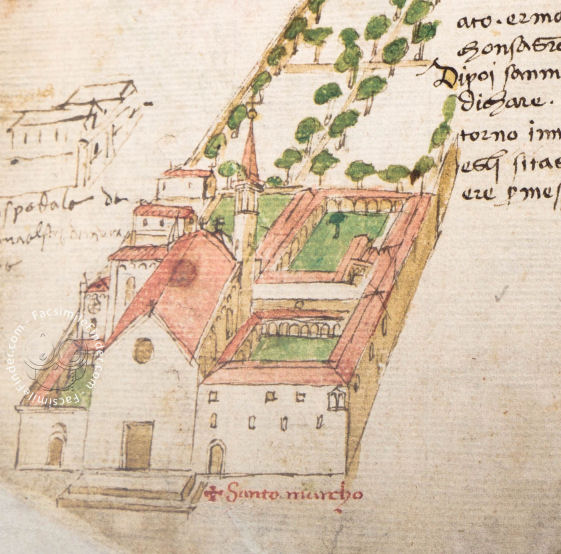 Medici, Antonino Pierozzi became archbishop of Florence in
1446 and was canonised as Saint Antoninus on 31st May 1523 by Pope Adrian
VI. The saint's remains are now in the Salviati Chapel. A later notable prior here was Girolamo Savonarola. Medici, Antonino Pierozzi became archbishop of Florence in
1446 and was canonised as Saint Antoninus on 31st May 1523 by Pope Adrian
VI. The saint's remains are now in the Salviati Chapel. A later notable prior here was Girolamo Savonarola.Vasari later 'modernised' the church, presumably by removing a screen, but it acquired its present form in 1588 to a design by Giambologna, with the façade built 1777-78 to designs by the Carmelite friar Gioacchino Pronti. The image from the Codex Rustici (see right) show the church before the addition of the façade. The Dominicans were expelled in 1866 and the first cloister became a museum in 1869, with nearly all of Fra Angelico's surviving panel paintings moved there in 1921. Interior The church itself is aisleless and somewhat square, designed by Michelozzo, with four altars on the right and three on the left, the last bay being a chapel more like a transept arm. Some 14th-century fresco fragments between the altars on the left, and to the right of the door on the inner facade is an Annunciation fresco, positioned in emulation of the famed miracle-working Annunciation in Santissima Annunziata. Mostly minor 16th-century altarpieces. The Crucifix which hangs over the main entrance was said to be by Giotto by Vasari, but is now widely thought to be a studio work of c.1310/20. An attribution to Simone di Puccio has also recently been suggested. On the right the first altarpiece is by Santi di Tito. Next is a Virgin and Six Saints of 1509 by Bartolomeo della Porta (Fra' Bartolomeo). The impressive Byzantine mosaic of the Virgin in Prayer is thought to date from the early 8th century and to have been in the old St Peter's in Rome. Its impact is somewhat diluted by being surrounded by frescoes of saints and putti in imitation of mosaic, added in the 17th century. The dome was frescoed by Alessandro Gherardini in 1717. The rather baroque wooden ceiling by Pier Francesco Silvani is from 1679. The church originally, and more modestly, copied the burial church of the order's founder, San Domenico in Bologna, in having a wooden roof over the main nave and stone vaulting over the more holy space for the friars. Two screens originally divided up the space for men, women and friars, with the women kept safely furthest from the friars while they performed the Mass. The large transept-like chapel is Giambologna's Chapel of Sant'Antoninus, built in 1580 for the Salvin family. The saint is is buried here, at the end on the left, and there is some good mannerist stuff, including an altarpiece of The Descent into Limbo by Allori. Also Il Poppi's Christ Healing the Leper and The Calling of Saint Matthew on the left and right walls. The murals in the cupola are by Pocetti The humanists Pico della Mirandola and Angelo Poliziano are interred between the second and third chapels on the left. Their tomb slabs are on the wall behind the sculpture of Savonarola (see below right) of whom Pico had been an influential ally. (He brought the apocalyptic preacher back to Florence, despite his earlier failure to connect with the people of Florence, an action which led to the arguably the grimmest period in Florence's history.) These tombs were opened in 2007 when their deaths in 1494 being likely from arsenic poisoning was confirmed. Lost art The Coronation of the Virgin of 1402 by Lorenzo di Niccolò, commissioned for the high altar here by the Sylvestrines, was given to the Dominicans of the church of San Domenico in Cortona in 1440 by Cosimo de' Medici just before the Fra Angelico altarpiece replaced it here. The main panel of Fra Angelico's San Marco Altarpiece (finished by 1443) (see one reconstruction below) painted for the rebuilt church, is now in the museum next door. It was removed from the high altar and disassembled in 1678/79. It is a very early example of the single-field square pala quadrata and the Medici's first major altar donation in Florence. In 1438 Cosimo and Lorenzo had paid the Caponsacchi family for the rights to the main chapel. The original frame is lost. Cosimo as patron is not depicted, but is represented by his family's patron saints, Cosmas and Damian. (Cosimo had a twin brother called Damiano who died young.) On the Virgin's right are Saints Lawrence and John the Evangelist, also family patron saints, and Saint Mark, the convent's patron. On her left are Saints Dominic, Francis and Peter Martyr. The angels on her left look to be the work of Benozzo Gozzoli, Angelico's assistant at the time. The altarpiece originally consisted of at least 26 panels, of which 18 remain. The very evident Seljuk-style Anatolian carpet may have belonged to San Marco and shows Angelico's skill with perspective. 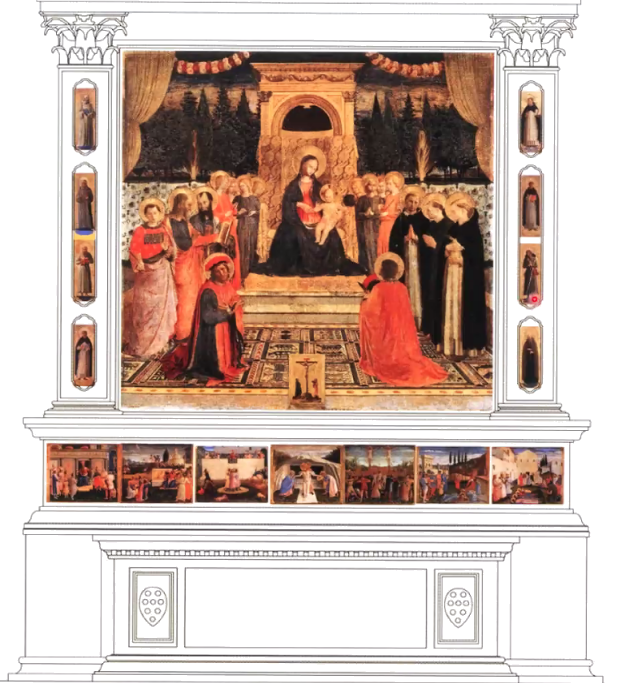 The altarpiece's nine predella panels - seven along the front and one miracle at each end around the corner - depicting scenes from the lives of Saints Cosmas and Damian, mostly the attempts to martyr them, are in many galleries. The Louvre has the gory Martyrdom with the decapitated heads rolling around on the floor still sporting their halos. The Alte Pinakothek in Munich has four panels, including the famous central Entombment, which technically might be called a Pieta and which somehow inspired Rogier van der Weyden's Entombment, commissioned by Cosimo around 1463/4. The other three in Munich have had the hand of Benozzo Gozzoli detected, including the Saints Cosmas and Damian before the Proconsul Lysias and in case you don't know the story the evil Proconsul has his name written on his large red hat. Washington and Dublin have one each, the latter, showing the saints at the stake, also featuring Lysias with his name on his hat. The San Marco museum here has two, including The Dream of Saint Justinian, the posthumous miracle where Cosmas and Damian replace the leg of an amputated man with a black one. The central Entombment panel forms an axis with the Crucifixion panel set into the bottom of the main register and the Christ child. Eight small full-length saints from flanking supports of the frame are to be found in the Lindenau-Museum, Altenburg (which has three), a private collection, Hampton Court and the Cini Collection in Venice. The last two, Dominican saints, one of them Vincent Ferrer, were found in England in 2007 and sold at auction for £1.7m. Update October 2025 Almost all of the remaining panels mentioned above have been reunited for the Angelico exhibition at the Palazzo Strozzi, until 26th January 2026. The Altarpiece of the Purification by Benozzo Gozzoli of 1461-2 was commissioned by the youth confraternity of the Purification of the Virgin and of Saint Zenobius who met in a room off the second cloister here. The main panel of the Virgin and Child Enthroned with Saints and Angels (see right) is in the National Gallery in London and the predella panels are in Berlin, Washington, Philadelphia, the Brera and the Queen's Collection. Gozzoli was a pupil of Fra Angelico and the altarpiece's contract specified that the Virgin should be 'in likeness' with the figure in Angelico’s San Marco altarpiece discussed above. In 1506 the altarpiece was moved to the confraternity’s grand new oratory nearby, paid for by Cosimo de' Medici, and by 1757 was in the refectory of the Ospedale dei Pellegrini in Via San Gallo. In 1483 the then prior Francesco Salviati commissioned Piero del Pollaiolo to paint an altarpiece showing Antonino Pierozzi (the first prior here, later canonized) at the foot of the Crucifix. It was placed on the altar of his tomb which was then to be found on the screen here. It was recently restored and is now (January 2024) on display in the refectory in the museum here. Botticelli's Coronation of the Virgin, an altarpiece originally in the chapel of Sant'Alò here. It was commissioned by the Guild of Goldsmiths and was painted between 1488 and 1490. It's been in the Uffizi since 1796. Many works by Fra Bartolommeo. His Christ in the Temple (1516), now in the Kunsthistorisches Museum Vienna, had been in the Uffizi but they swapped it with Vienna for Dürer's Adoration of the Magi in 1793. His dark Virgin and Child with Saints was painted for the Santa Caterina altar here, and is now in the Palatine Gallery in the Palazzo Pitti. It was acquired by Grand Prince Ferdinando, who deprived many Florentine churches of their altarpieces, either by providing cash or replacement copies. Also in the Pitti is a huge Sistine-ceiling-inspired panel of Saint Mark by Fra Bartolomeo, acquired from San Marco by Napoleon in 1799. It was mounted on canvas and later returned to Florence. A matching Saint Sebastian, sent to the French king in 1529, is now lost. It is said that it had to be removed from the choir screen here as it was prompting sinful thoughts in the laywomen waiting to confess, but this story may be a fabrication. Church opening times Monday - Friday 8.15 – 1.20 Saturday 8.15 – 4.20 Sunday Closed Update October 2025 The façade is all covered in scaffolding and sheeting. |
|
|
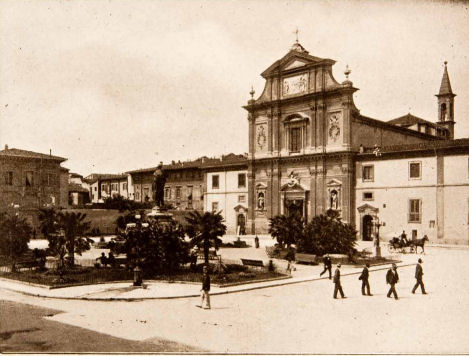 The San Marco Convent Museum |
||
|
Upon entering you find yourself in Michelozzo's Cloister of Saint Antonino, which has quite vivid frescoes in the lunettes, some by Fra Angelico (the five small ones over the doors in the corners) but mostly they are by an artist called Giovanni Antonio Sogliani, amongst others, painted later and showing scenes from the life of Saint Antoninus, the first prior here. Facing you along the arm of the cloister as you enter is a large fresco of Saint Dominic worships the Crucifix (1442) by Fra Angelico, with added flanking figures of The Mourning Virgin and Saint John by Cecco Bravo in 1628 (see photo right). The marble frame and slab were added later, and the fresco was cropped, when the Fabbroni family were granted this corner. The first room on the right, formerly The Pilgrim's Hospice, now displays panel paintings by Fra Angelico taken from other (mostly closed or demolished) churches and convents. Completely refurbished during the 2020 lockdown, this room is now called the Sala del Beato Angelico. Carrying on anti clockwise around the cloister takes you to a large refectory with unspecial work along the right-hand wall, a quite impressive fresco of The Last Supper of Saint Dominic (with the Crucifixion taking place above) by our friend Sogliani, a former pupil of Lorenzo di Credi, on the end wall, and more by him up the left side. Instead of the Saint Dominic Sogliani had wanted the main scene to be The Feeding of the Five Thousand and provided a drawing, but the brothers wanted something simpler. Vasari admires the work but says that Sogliani should have been allowed to paint his choice 'because painters express the conceptions of their own minds better than those of others'. Opposite is a small room more worthy of attention with some sweet Fra Bartolomeo panels and his famous dark post-mortem profile Portrait of Savonarola. Fra Bartolomeo was a fellow Dominican and a great admirer of Savonarola, even being imprisoned with him in 1498. The refectory here was enlarged in the 16th century with the loss of a Crucifixion fresco on the former end wall by Fra Angelico. For the new end wall of the extended refectory Antonio Sogliani painted a fresco of The Miraculous Supper of Saint Dominic in 1536. The subject is a more Dominican version of The Miracle of the Loaves and Fishes. Next around the cloister is a The Chapter House, a square room with a big and lovely Crucifixion fresco by Fra Angelico (1441-2), but looking much more worked than his usual (see right). It's the largest work that he made here. On Christ's right hand are the group around the Virgin (Mary of Cleophas, Mary Magdalene and John the Baptist) and the patron saints of Florence and the Medici, painted in bright colours. To his left are the founders of five religious orders, led by Saint Dominic, painted in duller earth colours. The Dormitory and Library Next is upstairs. The works up here would practically only have been seen by the friars, until the general public were allowed in in 1869 when the museum was opened. On the first floor are the 44 small cells containing 40 frescoes, painted 1441-43, for private contemplation by Fra Angelico and his studio, including Benozzo Gozzoli. In addition Battista di Biagio Sanguigni and Zanobi Strozzi, long-standing acquaintances and assistants are the names most often mentioned. All were painted in true fresco, and swiftly, it seems. It was unusual to have such large images in dormitory rooms. The large Annunciation at the top of the stairs is justly one of Fra Angelico's most well-known and loved works. It is somewhat austere in colour and traditional in execution, as is fitting for the brothers. The scenes in the cells are even more austere (see below right) to the point of sometimes almost seeming unfinished. Turning left here takes you down the east corridor, the clerics' dormitory, with the paintings in the cells here largely by Fra Angelico himself. For the clerics their are scenes from the life of Christ or the Virgin, witnessed by one of the major Dominicans - Dominic, Peter Martyr or Thomas Aquinas - like the Annunciation (right) in cell 3, with Peter Martyr praying behind the Angel. The scenes in the 20 cells of the clerics are more theologically complex than those in the novices' and lay brothers' cells. In this corridor is the renowned Virgin of the Shadows (see below) so named for the distinct shadows cast by the column capitals, painted as if thrown by light from the only window in the corridor. It is ranked as a mature high point in his career. 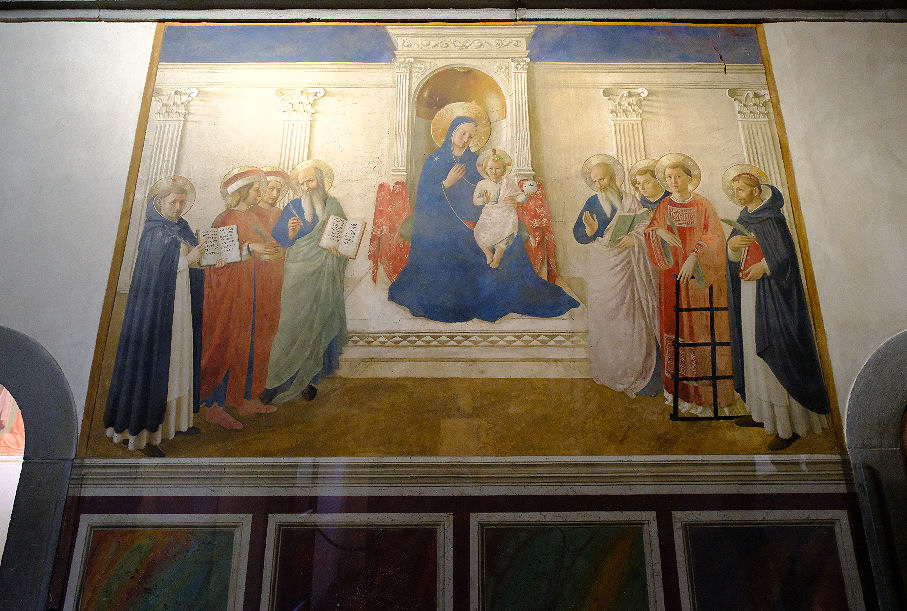 This corridor leads to the south corridor, the novices' dormitory, (cells 15-21) where the images are of Saint Dominic Adoring the Crucifixion and are more instructive, as befits the cells of young boys in training. This was the last corridor completed, and said to be mostly the work of Angelico's assistants. At the end of this corridor is Prior Savonarola's rooms. Retracing your steps and turning right back at the Annunciation, takes you into the north corridor, the dormitory of the lay brothers', or conversi, (cells 31-44) mostly the work of Benozzo, where the first cell on your left is that of Saint Antoninus. The lay brother' cells all have straightforward narrative scenes from the New Testament, as appropriate for less educated brothers who attended to the community's domestic needs. Aside from the famous Annunciation the north corridor also contains a large Saint Dominic Adoring the Crucifix. On the right you reach the entrance to Michelozzo's famous library. Long lauded as a fine typical Brunelleschi-inspired renaissance interior with its white walls and pietra serena details, the walls were recently discovered, under plaster applied since suppression, to have been green, a colour said to be symbolic of contemplation often used at the time for the walls of libraries. The vaulted aisles and barrel-vaulted ceiling makes this one of the few parts of the complex that doesn't have a wooden ceiling, denoting its importance, and the need to minimise the risk of fire. A door at the end of the library leads to the Greek Library, built to compliment the 'Latin library' in 1457. It's impressive polychrome ceiling, painted in imitation of coloured marbles, would originally have been set of by the green walls, The early 18th century bookcase house 130 codices, mostly from convents suppressed in 1866. Vases from the Old Pharmacy are also on display here. Just outside the entrance to the library is a plaque commemorating Savonarola's arrest here on April 8th 1498. At the end of this corridor are the cells used by Cosimo de' Medici, and where Pope Eugenius slept before he consecrated San Marco on Epiphany 1443. They contain an Adoration of the Magi, a characteristic Medici subject, by Fra Angelico and, mostly, Benozzo Gozzoli, his assistant at the time, who went on to later famously paint the same subject for the Medici in the chapel of the Medici-Riccardi Palace. Back down stairs is the Museo di Firenze Antica established in 1898 in the Foresteria (guest quarters) to house architectural fragments from the controversial demolition of the Mercato Vecchio. A fine Last Supper based on Ghirlandaio's Ognissanti fresco, but here probably mostly the work of assistants, is in the small refectory that was the gift shop until recently (see right). It was restored in 1994/5 when some oil overpainting was removed. The prophets and sibyls around the edges are said to be by Benozzo. From windows in the corridor you can see into the (not visitable) cloister of Saint Dominic. There is a new gift and books shop now just before the exit Museum opening times Monday - Friday 8.15 - 1.50 Saturday, Sunday and Holidays 8.15 - 4.50 Closed 2nd and 4th Monday and 1st, 3rd and 5th Sunday of each month. Update October 2025 A major Fra Angelico exhibition at the Palazzo Strozzi, until 26th January 2026, means that some works from San Marco have been loaned, but there is a companion exhibition here for the duration with the gaps filled with a lot of loans, amounting to an exhibition of early works |
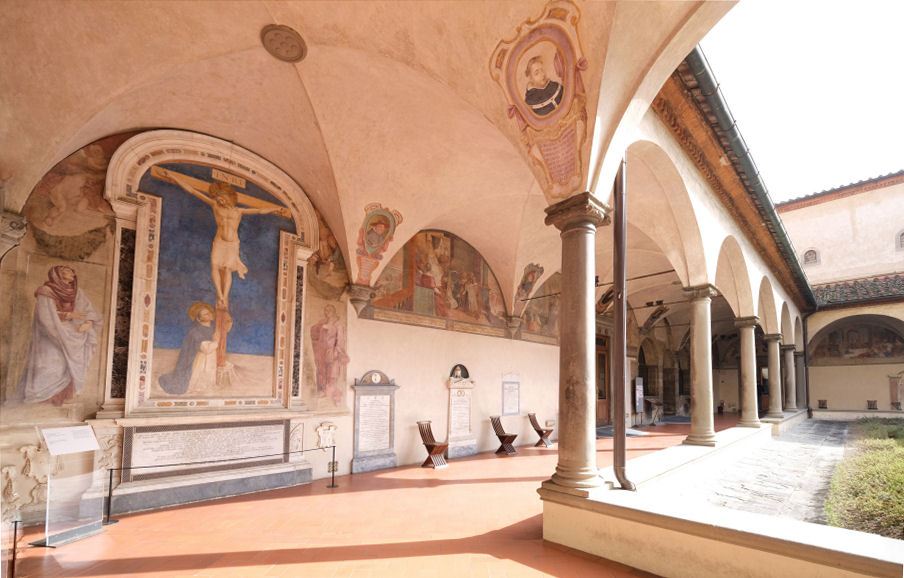 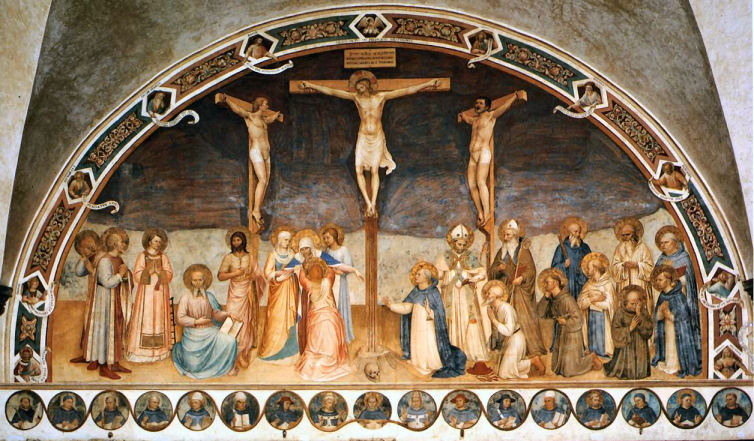 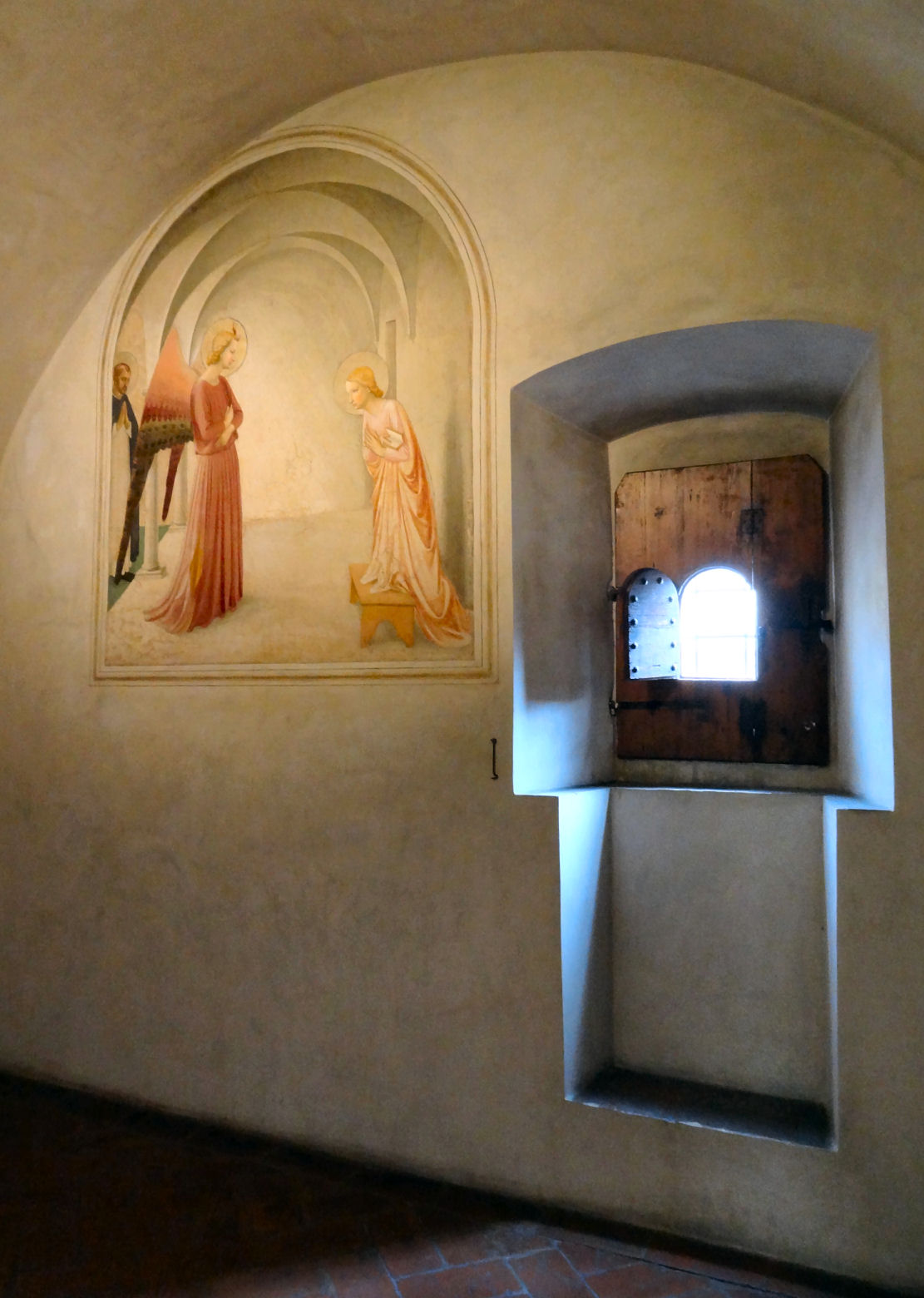 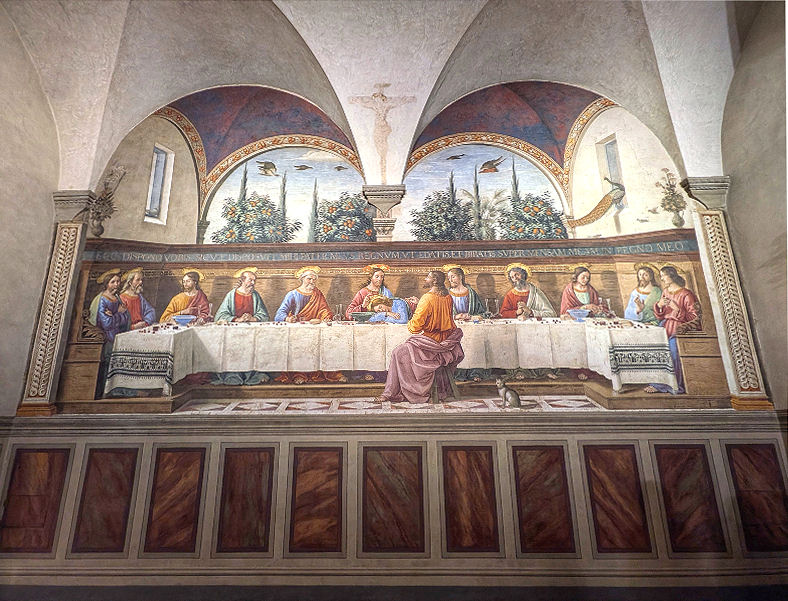 |
|
|
|
||